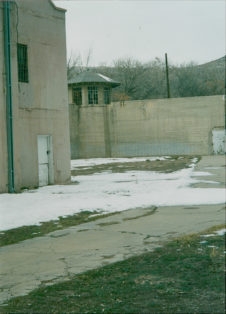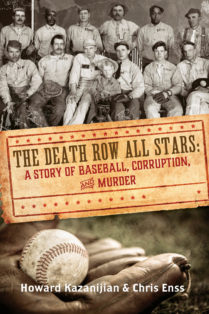Enter to win a copy of
The Death Row All Stars: The Story of Baseball, Corruption, and Murder.

In November 1911 winter weather had moved in, and the Wyoming State Penitentiary infirmary was filled to near overflowing with violently ill inmates. Patients with no beds to lie on sat on the floor, propped up against the wall. Some were drawn into a fetal position and others were draped faced down across thin pillows scattered around the room. The air was pungent and oven-hot. The sound of sick convicts retching into buckets and tin pans echoed throughout the crowded medical unit.
Joseph Seng hurried from one patient to another, assisting Dr. Maghee. He mopped the damp sweat off the prisoners’ heads, gave them drinks of water, and fed them chips of ice. Guards escorted more ailing men into the medical unit and dropped them wherever they could find space. The sick inmates moaned in pain and some cried out for relief.
After several hours of listening to the suffering, collecting the vital signs of each patient, and analyzing the symptoms, the doctor and his assistant determined that the men, including several members of the baseball team, had been poisoned. News of their illness and speculation that the poisoning might have been a deliberate act spread quickly throughout the prison. Several prison guards, including D. O. Johnson, considered the possibility that someone with a grudge against the penitentiary baseball team and its chance to compete in future games might have orchestrated the poisoning. There was some chatter between the guards and prisoners that Otto Gramm could be behind the trouble.
Gramm, naturally, was not unhappy about the news that problems were still plaguing the prison under Warden Alston’s watch. He was rumored to have been offended by a column that had appeared in the November 3, 1911, edition of the Lander, Wyoming, newspaper the Lander Eagle. The headline read Carey Saving Good Money—Better Than Gramm. The article that followed contained a statement of the affairs of the Wyoming State Penitentiary and showed significant improvements on financial and other fronts. “The people are entitled to know and the books of the administration are open to all,” Governor Carey was quoted in the report. “The results of the administration of the penitentiary under the new arrangement can best be summed up by presenting a statement of what the penitentiary [would have] cost the state had Otto Gramm been allowed to remain in his position there,” the article continued.
“It’s shown that the average daily per capita cost to the state was $.61 cents for the year ending September 30, 1910, made up by the $.50 cents per day per prisoner paid to Mr. Otto Gramm, lessee, and the $.11 cents per day per prisoner paid for permanent improvements, discharge money, etc. Had the Gramm contract continued the expense to that would have been more than $25,000.00.”
Luckily, with Seng’s help, Dr. Maghee was able to relieve the prisoners of their misery. The pair mixed a concoction of mustard and Coca-Cola that helped to purge the toxins from the sick convicts. Patients and prison officials praised the doctor and Seng for bringing an end to the outbreak. Within twenty-four hours of the incident occurring, health had been restored and inmates returned to their cells. According to the November 6, 1911, edition of the Laramie Daily Boomerang, the cause of the poisoning turned out to be contaminated food. “A quantity of kraut had been allowed to remain in a metal pot overnight,” the article read, “and along the edge had absorbed poison and in a few minutes after eating it many prisoners were in intense pain.”
George Saban kept himself clear of any disputes with fellow inmates and aligned himself with more than one guard who had an allegiance to Otto Gramm. Saban had a problem with other prisoners only when they stood in the way of his money-making ventures. News that law enforcement was cracking down on illegal gambling throughout the state was the basis for his frustration that fall, beginning in September 1911.


